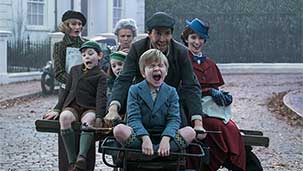Usually, in musicals, the soundtrack gets all the love. In Mary Poppins Returns, the songs are fantastic and the choreography is just as fun. But it’s your masterful slicing and dicing of ambient tones that really pop off the screen. The shuffling of feet, the clank of a lamp post, the boom of a cannon—and all the other onomatopoeic sounds you and your team whipped together is what truly makes the impossible, possible.
I find foleying to be the most interesting aspect of filmmaking. Recreating everyday sounds during post-production is the definition of movie magic for me. We as moviegoers are so used to being deceived by the eyes, we don’t pay attention to all the ways we’re being deceived by foley artists on the daily. Is that really a car door closing or somebody punching a piece of steak in a sound studio in south Burbank? We will never know…
More impressive is how those recreated sounds are interwoven into the larger production. Basically, your day job.
In the case of Mary Poppins Returns, not only do you have to be immensely skilled at the art of editing, you have to also have an ear for rhythm and melody. You have to know how the creaky turning of a bicycle wheel can complement a high note. Or how the chime of a bell can add whimsy. Editing foleyed sounds into a musical makes the entire experience more tangible. When done right, it makes it magical.
Upon relistening of the official Mary Poppins Returns soundtrack online, I couldn’t help but feel something was missing. A certain charm? A certain beat? I like to think all of the above.
Why?
Because all of the foleyed bits you added to the final product were taken out. It makes sense since foleying is reserved for a visual medium. Audiences need to be able to see what’s happening and how the sounds correspond in order for foleying to be truly impactful. Or else a car horn can seem jarring when not shown in context.
The music is still full of wonder and excitement but it’s missing that extra punch. That tiny little note that transforms the Mary Poppins Returns experience as a whole.
One such moment that benefits from your work is the awe-inspiring musical number,“Trip a Little Light Fantastic”. The premise is simple. Lin-Manuel Miranda who plays Jack—a lovable chimney sweep from the first film, all-grown up to be a lovable lamplighter—helps Mary Poppins and the Banks children find their way home with an elaborate song.
On a side note: I like to think this is how all adventures with Lin-Manuel Miranda end up. Period.
The whole appeal of the lamplighters in Mary Poppins Returns is how happy they are despite living in poverty. They don’t have much but that doesn’t stop them from being humble, fun, and a little goofy. That’s why your sounds are so important. Much like the lamplighters, your sounds help shine a light during a dark and dreary time. The scuffling of worn out shoes, the thud of a rusty ladder, the woosh of thick fabric...all wonderful instruments when seen in a positive light.
A positive light that is truly contagious.
I had to commute for over an hour in the middle of Canadian winter to catch a screening of Mary Poppins Returns. I didn’t have an extra ticket for a plus one, and I was surrounded by a bunch of loud, shrieking children. All the signs pointed to Ankit not being a happy camper. But thanks to your brilliant editing paired with the supercalifragilisticexpialidocious world of Mary Poppins, I was grinning from ear-to-ear.
Sincerely,

Ankit







